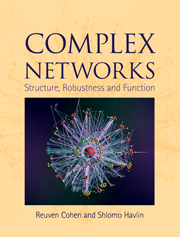Book contents
- Frontmatter
- Contents
- 1 Introduction
- PART I RANDOM NETWORK MODELS
- 2 The Erdős–Rényi models
- 3 Observations in real-world networks: the Internet, epidemics, proteins and DNA
- 4 Models for complex networks
- 5 Growing network models: the Barabási–Albert model and its variants
- PART II STRUCTURE AND ROBUSTNESS OF COMPLEX NETWORKS
- PART III NETWORK FUNCTION: DYNAMICS AND APPLICATIONS
- Appendix A Probability theoretical methods
- Appendix B Asymptotics and orders of magnitude
- Appendix C Algorithms for network simulation and investigation
- References
- Index
4 - Models for complex networks
from PART I - RANDOM NETWORK MODELS
Published online by Cambridge University Press: 05 August 2013
- Frontmatter
- Contents
- 1 Introduction
- PART I RANDOM NETWORK MODELS
- 2 The Erdős–Rényi models
- 3 Observations in real-world networks: the Internet, epidemics, proteins and DNA
- 4 Models for complex networks
- 5 Growing network models: the Barabási–Albert model and its variants
- PART II STRUCTURE AND ROBUSTNESS OF COMPLEX NETWORKS
- PART III NETWORK FUNCTION: DYNAMICS AND APPLICATIONS
- Appendix A Probability theoretical methods
- Appendix B Asymptotics and orders of magnitude
- Appendix C Algorithms for network simulation and investigation
- References
- Index
Summary
Introduction
In this chapter and the following one, we will discuss models for generating complex networks. These models describe the process of creating complex networks and thus also define probability spaces of random graphs. As expected, different methods of creation can lead to different classes of random graphs having completely different properties. We will discuss the properties of networks formed by some of these methods in the second part of this book. This chapter will mainly focus on static models, that is, models for building a complex network with a given set of nodes, and some wiring process (for connecting nodes by links), depending on the desired properties of the network.
It should be clarified that real networks are not random. Their formation and development are dictated by a combination of many different processes and influences. These influencing conditions include natural limitations and processes, human considerations such as optimal performance and robustness, economic considerations, natural selection and many others. Controversies still exist regarding the measure to which random models represent real-world networks. However, in this book we will focus on random network models and attempt to show how their properties may still be used to study properties of real-world networks.
Information
- Type
- Chapter
- Information
- Complex NetworksStructure, Robustness and Function, pp. 31 - 50Publisher: Cambridge University PressPrint publication year: 2010
